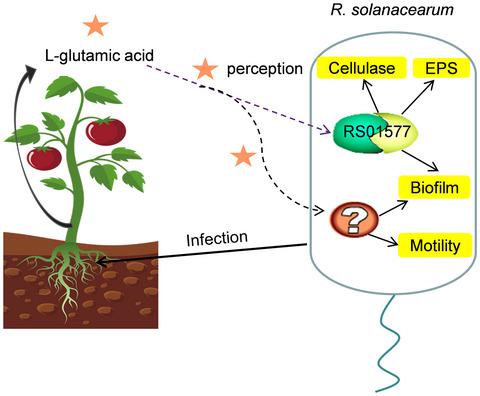当前位置:
X-MOL 学术
›
Mol. Plant Pathol.
›
论文详情
Our official English website, www.x-mol.net, welcomes your feedback! (Note: you will need to create a separate account there.)
Ralstonia solanacearum promotes pathogenicity by utilizing l-glutamic acid from host plants.
Molecular Plant Pathology ( IF 4.9 ) Pub Date : 2020-06-29 , DOI: 10.1111/mpp.12963 Fangfang Shen 1 , Wenfang Yin 1 , Shihao Song 1 , Zhihan Zhang 1 , Peiyi Ye 1 , Yong Zhang 2 , Jianuan Zhou 1 , Fei He 1 , Peng Li 3 , Yinyue Deng 4
Molecular Plant Pathology ( IF 4.9 ) Pub Date : 2020-06-29 , DOI: 10.1111/mpp.12963 Fangfang Shen 1 , Wenfang Yin 1 , Shihao Song 1 , Zhihan Zhang 1 , Peiyi Ye 1 , Yong Zhang 2 , Jianuan Zhou 1 , Fei He 1 , Peng Li 3 , Yinyue Deng 4
Affiliation

|
Ralstonia solanacearum is an important bacterial pathogen that can infect a broad range of plants worldwide. A previous study showed that R. solanacearum could respond to exogenous organic acids or amino acids to modulate cell motility. However, it was unclear whether R. solanacearum uses these compounds to control infection. In this study, we found that R. solanacearum GMI1000 uses host plant metabolites to enhance the biosynthesis of virulence factors. We demonstrated that l‐glutamic acid from host plants is the key active component associated with increased extracellular polysaccharide production, cellulase activity, swimming motility, and biofilm formation in R. solanacearum GMI1000. In addition, l‐glutamic acid also promoted colonization of R. solanacearum cells in the roots and stems of tomato plants and accelerated disease incidence. Furthermore, genetic screening and biochemical analysis suggested that RS01577, a hybrid sensor histidine kinase/response regulator, is involved in l‐glutamic acid signalling in R. solanacearum. Mutations in RS01577 and exogenous addition of l‐glutamic acid to the GMI1000 wild‐type strain had overlapping effects on both the transcriptome and biological functions of R. solanacearum, including on motility, biofilm formation, and virulence. Thus, our results have established a new interaction mechanism between R. solanacearum and host plants that highlights the complexity of the virulence regulation mechanism and may provide new insight into disease control.
中文翻译:

青枯雷尔氏菌通过利用来自宿主植物的1-谷氨酸来促进致病性。
青枯雷尔氏菌是一种重要的细菌病原体,可以感染全世界的多种植物。先前的研究表明青枯菌可对外源有机酸或氨基酸作出反应,以调节细胞运动。然而,尚不清楚青枯菌是否使用这些化合物来控制感染。在这项研究中,我们发现青枯菌GMI1000使用宿主植物代谢产物来增强毒力因子的生物合成。我们证明,寄主植物中的l-谷氨酸是与番茄茄中胞外多糖产量增加,纤维素酶活性,游泳运动和生物膜形成相关的关键活性成分。GMI1000。此外,升谷氨酸也促进定植青枯雷尔氏菌在根部细胞和番茄植物和加速发病的茎。此外,遗传筛选和生物化学分析表明,RS01577,一个混合传感器组氨酸激酶/调节器响应,参与升在谷氨酸信令青枯菌。在突变RS01577和外源添加的升谷氨酸到GMI1000野生型菌株已重叠上的转录和生物两种功能效应青枯,包括运动性,生物膜形成和毒力。因此,我们的结果建立了青枯菌与寄主植物之间新的相互作用机制,突显了毒力调控机制的复杂性,并可能为疾病控制提供新的见识。
更新日期:2020-06-29
中文翻译:

青枯雷尔氏菌通过利用来自宿主植物的1-谷氨酸来促进致病性。
青枯雷尔氏菌是一种重要的细菌病原体,可以感染全世界的多种植物。先前的研究表明青枯菌可对外源有机酸或氨基酸作出反应,以调节细胞运动。然而,尚不清楚青枯菌是否使用这些化合物来控制感染。在这项研究中,我们发现青枯菌GMI1000使用宿主植物代谢产物来增强毒力因子的生物合成。我们证明,寄主植物中的l-谷氨酸是与番茄茄中胞外多糖产量增加,纤维素酶活性,游泳运动和生物膜形成相关的关键活性成分。GMI1000。此外,升谷氨酸也促进定植青枯雷尔氏菌在根部细胞和番茄植物和加速发病的茎。此外,遗传筛选和生物化学分析表明,RS01577,一个混合传感器组氨酸激酶/调节器响应,参与升在谷氨酸信令青枯菌。在突变RS01577和外源添加的升谷氨酸到GMI1000野生型菌株已重叠上的转录和生物两种功能效应青枯,包括运动性,生物膜形成和毒力。因此,我们的结果建立了青枯菌与寄主植物之间新的相互作用机制,突显了毒力调控机制的复杂性,并可能为疾病控制提供新的见识。



























 京公网安备 11010802027423号
京公网安备 11010802027423号